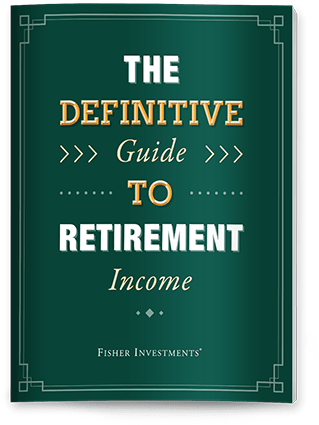Income Risks
As you approach retirement, you may think it wise to shift your portfolio away from growth and more towards income generation. Although buying fixed-income or dividend-producing investments can help generate income to fund your retirement, focusing your portfolio too narrowly on generating income may leave you susceptible to other portfolio risks.
At Fisher Investments, we can help you assess some of the risks associated with income-producing investments. There are many retirement planning strategies, but it is important to understand the potential pitfalls that come with investing only for income in retirement, and to learn about alternative ways to invest to achieve your financial goals.
Less Risk? Not Necessarily
Some investors may assume income-generating investments are “safer” than other investments, but this can be a dangerous assumption. Every investment has risk, and common investments used to generate income in retirement are no different. The risks for income-generating investments can include the following:
- Low yields or falling interest rates can lead to income shortfalls, forcing you to unexpectedly sell holdings to make up the difference and potentially making it harder to achieve your financial goals. The risk of not reaching your long-term goals can be the greatest risk of all.
- Rising interest rates can make your current fixed-income holdings less valuable since interest rates and prices have an inverse relationship.
- Inflation may reduce the spending power of your income-generating investments.
- Many equities that pay dividends are concentrated in a few sectors, which can lead to a lack of diversification if your portfolio is focused too heavily on dividend-paying equities. Even in retirement, it is important to keep a diversified portfolio to reduce concentration risk and volatility. Additionally, no company’s dividends are guaranteed. Dividends can be cut or eliminated at any time at the company’s discretion.

See Our Investment Guides
The world of investing can seem like a giant maze. Fisher Investments has developed several informational and educational guides tackling a variety of investing topics.
A Closer Look: The Risks of Common Income-Generating Investments
Let’s look at several popular income-generating investments and consider some of the specific risks associated with each. Investors should keep these considerations in mind as they craft an investment strategy optimized for income in retirement.
Bonds
Whether you use individual bonds, mutual funds or exchange-traded funds, bond exposure can help reduce short-term volatility while producing income in retirement. Risks associated with bond investments can include interest rate and duration risk (rising rates can make current holdings less valuable), reinvestment risk (having to reinvest bonds at potentially lower rates, even if held to maturity), inflation risk (your bond’s fixed coupon losing purchasing power because of rising inflation) and credit risk (the risk that your bond will stop coupon payments or won’t repay its principal). Certain types of bonds have different levels of credit risk:
- Investment-grade bonds: These bonds typically have less credit risk than high-yield bonds, particularly bonds like Treasurys that are backed by the US federal government. Although they are sometimes considered safer, investment-grade bonds typically have lower yields than high-yield bonds, while often offering less growth than equities. Investors who focus too heavily on income in retirement may find it difficult to reach their long-term goals if such low rates of return persist.
- High-yield bonds: These bonds tend to produce greater yield, but in general, the higher a bond’s yield, the greater the underlying credit risk of the entity offering it. While the odds of the US government defaulting on Treasurys is close to zero, a new startup company may not exist 10 years from now and may be unable to pay its debt. Yields generally reflect this risk, with higher yields accompanied by higher credit risk.
Dividend-Paying Stocks
Many investors assume that a stock paying regular dividends is “safer,” but this isn’t necessarily true. Stocks aren’t more or less safe because they pay a dividend, and companies can cut or suspend their dividend at any time. Additionally, since businesses that pay dividends are more commonly found in certain sectors, like Consumer Staples or Utilities, investors looking for income in retirement through these types of stocks could end up unintentionally concentrated in just a few sectors. Investors focused on income-producing stocks may risk missing out on future growth if they lack sufficient exposure to other sectors.
Master Limited Partnerships (MLPs)
MLPs were created by Congress in the 1980s in the hope of generating more attention toward energy-infrastructure investment. The aim was to create a security with limited-partnership-like tax benefits, but publicly traded—bringing more liquidity and fewer restrictions. MLPs are generally concentrated in the energy sector; however, investing too heavily in MLPs can concentrate an investor’s portfolio and increase risk. Because MLPs are “pass-through” structures, they can offer tax advantages in taxable accounts:
- As a partnership, MLPs aren’t subject to corporate taxes.
- Losses and depreciation from the MLP can pass through to owners and lower owners’ tax burdens.
- Distributions aren't taxed immediately and are instead taxed when the MLP units are sold.
MLPs are commonly used for income generation because they must pass along a certain amount of cash to unit holders, along with the previously mentioned tax benefits. Unfortunately, much of this benefit is temporary. Because MLPs are concentrated in commodity sectors like Energy, when energy prices decline it can impact the MLP’s ability to distribute cash.
Real Estate Investment Trusts (REITs)
REITs are organizations that purchase various forms of real estate, collect rent from leases and collect revenue from sales. Because REITs are required to distribute 90% of their profits to shareholders, they are attractive as income- generating investments. Unfortunately, this limits their ability to reinvest and grow. Because REITs are concentrated in real estate, when the real estate market falls or rents drop, REITs can lose value, causing their yields to decrease. Non-traded REITs (REITs that you can’t buy and sell like a stock on a national exchange) can have additional limitations and risks:
- They can be difficult to value because they aren’t traded on an exchange.
- They can be difficult to sell because they are traded outside of exchanges and buyers can be harder to find.
- They tend to have diminished returns because of high fees.
Learn More About How to Use Income Investment Vehicles
All income-generating investments come with risks, and investors who focus primarily on income in retirement should thoroughly understand the specific risks involved. It is important to keep in mind that most of these investments aren’t inherently safer than any other investments, but rather expose investors prioritizing income in retirement to different kinds of risk.
Fisher Investments has an extensive history helping investors fund their retirements. We can help review your current investments to determine whether they are properly aligned with your financial goals. To learn more about our services, contact us today.




